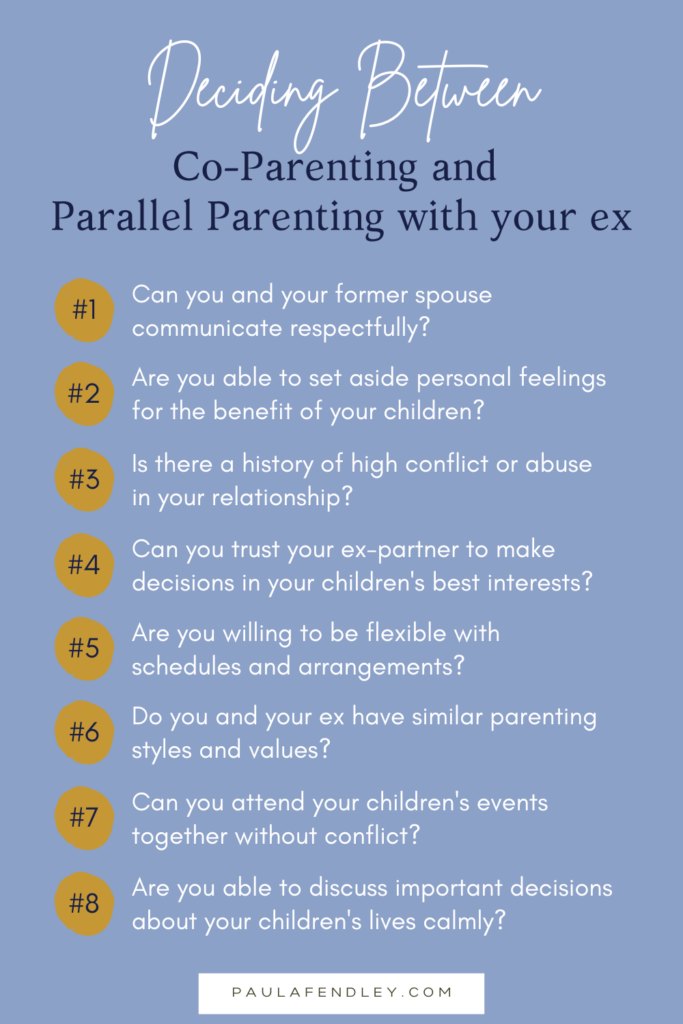During a separation or divorce involving children, one of the major decisions likely to be on everyone’s mind is how to move forward with parenting together while living apart. It can feel confusing and overwhelming to navigate these waters with everything else going on! Thankfully – you’re not alone. Ample research has been done in the field to determine the best options for any situation. These evidence-based structures can help support and guide you to the best solution for your family.
Two of the most common approaches to parenting alongside a former partner are co-parenting and parallel parenting. While both of these strategies aim to prioritize the children’s needs, they differ significantly in how the parents interact with one another. This article will explore these two parenting methods and their benefits to help you determine whether co-parenting or parallel parenting is the better option for your family’s unique situation.
Jump To:
What is co-parenting?
Co-parenting, often referred to as traditional co-parenting, is a collaborative approach to raising your children despite no longer being in a romantic relationship. This cooperative approach to parenting with your ex requires continuous open communication, mutual respect, and a focus on the children’s best interests. In order for co-parenting to be successful, both parents must be open to collaboration and coordination – something that can be difficult for exes with high levels of conflict.
Key aspects of co-parenting include:
-
- Regular, direct communication between parents
-
- Joint decision-making on important matters
-
- Flexibility in parenting time and schedules
-
- Shared responsibility for children’s activities and events
-
- Presenting a united front to children
-
- Willingness to compromise and problem-solve together
Benefits of co-parenting
If, as a divorced couple, you and your ex can successfully find a way to co-parent with effective communication and mutual respect, the benefits can be immense for you and your children. Co-parenting works best when both parents can set aside their personal differences for the benefit of the kids. Successful “co-parents” allow their children to have a relationship with two involved parents – trusting that they’re each creating a safe and peaceful environment.
When successful, a co-parenting relationship can offer numerous benefits to you, your ex, and most importantly, your kids.
Here are some of the specific benefits of this approach:
-
- Stability and security
-
- Consistency
-
- Demonstrates healthy conflict resolution
-
- Facilitates easier coordination
-
- Promotes a positive relationship between parents and children
-
- Easier emotional transition
What is parallel parenting?
Parallel parenting is an alternative approach for exes with joint custody, designed for high-conflict situations that lack effective communication. In this arrangement, “parallel parents” minimize direct interaction with one another while still sharing parental responsibilities. The goal of parallel parenting is to reduce conflict and provide a stable environment for children – despite tension between parents.
Key features of parallel parenting include:
-
- Adherence to a detailed parenting plan or court order
-
- Minimal direct contact between parents
-
- Clear boundaries
-
- Separate decision-making for day-to-day matters
-
- Joint decisions only on major issues affecting the children
-
- Use of written communication (e.g., text messages, emails, or a co-parenting app)
Benefits of parallel parenting
Parallel parenting can offer several advantages for high-conflict families. It’s not always possible for exes to get on the same page about the details of day-to-day parenting decisions immediately following a separation. Sometimes the easiest thing for both parties to agree on is that they don’t – and won’t – see eye to eye. In these cases, parallel parenting may offer the best possible chance for children to stay out of the crossfire that would result from too much direct contact between parents. In some cases, over time, parallel parenting may even offer enough space that parents can create a more peaceful relationship down the line that allows for more co-parenting to take place.
Here are some of the specific benefits of parallel parenting:
-
- Less conflict exposure for children
-
- Clear boundaries between households
-
- Less direct communication between parents
-
- Allows each parent to develop their own parenting style
-
- Provides structure and consistency for children
-
- Can lead to more peaceful interactions between parents over time
What type of parenting is best for kids after a divorce?
In an ideal world, all divorced couples would be able to co-parent effectively as that is the most peaceful and consistent solution for kiddos. However, the reality is that every family’s situation is unique, and what works best depends on dozens of personal factors. The best parenting approach after a separation is whichever allows for the most peace and consistency for all parties. Both co-parenting and parallel parenting can lead to positive outcomes for children provided that they’re implemented correctly.
The good news for your family is that both of these parenting models, when implemented correctly, are designed with the most up-to-date research in mind. It’s been shown that children benefit most when they have relationships with both parents (barring abuse or neglect), parental conflict is minimized, they feel loved and supported by both parents, there’s consistency and structure in their lives, and they feel that their needs are prioritized over parental disagreements. With support, both co-parenting and parallel parenting have the potential to tick all of these boxes for your children.
As you consider whether co-parenting or parallel parenting is the better option for you current circumstances, here are some helpful questions you can ask yourself to provide some clarity:
-
- Can you and your former spouse communicate respectfully?
-
- Are you able to set aside personal feelings for the benefit of your children?
-
- Is there a history of high conflict or abuse in your relationship?
-
- Can you trust your ex-partner to make decisions in your children’s best interests?
-
- Are you willing to be flexible with schedules and arrangements?
-
- Do you and your ex have similar parenting styles and values?
-
- Can you attend your children’s events together without conflict?
-
- Are you able to discuss important decisions about your children’s lives calmly?
If you answered “yes” to most of these questions, co-parenting might be a viable option. If you answered “no” to several, especially regarding communication and conflict, parallel parenting may be the better choice.

Final thoughts
Choosing how to move forward parenting with your ex is a big decision that can have a lasting impact on your children’s well-being. It’s essential to be honest about your family’s dynamics and choose the approach that will best support your children’s needs. However, it’s equally important to remember that there is no one-size-fits-all approach to parenting! As long as you choose the best option for your family and seek support when it’s needed, you are doing the best you can for your children.
Keep in mind that the parenting method you choose right now isn’t necessarily permanent. As emotions settle and circumstances change, parents who start with parallel parenting may eventually transition to a more collaborative co-parenting arrangement. The key is to remain focused on providing a stable, loving environment for your children. Whether through co-parenting or parallel parenting, the goal should always be to provide children with the love, support, and stability they need to thrive.
If you’re struggling to determine the best approach or to implement a parenting plan, don’t hesitate to seek support. As a Transition and Divorce Coach, I would be honored to help you navigate this challenging chapter of your life. Together, we can create a path forward that feels hopeful and authentic to you.

